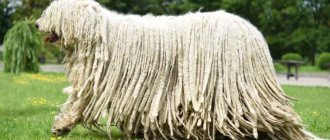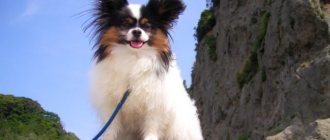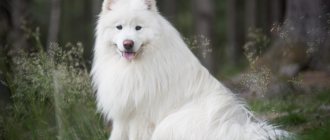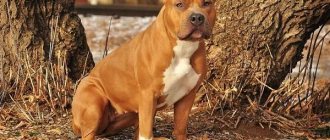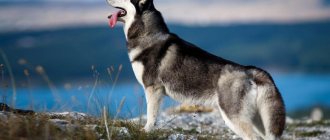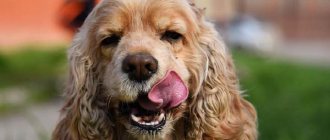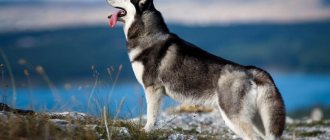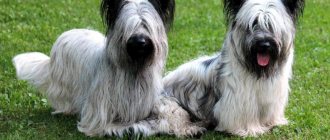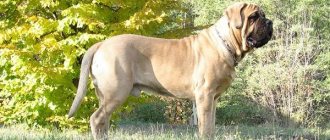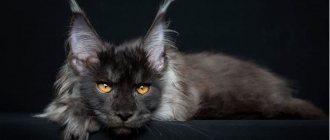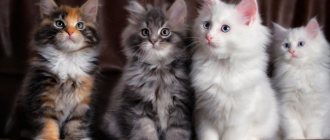When choosing a pet, many owners are guided by its appearance. Some are fascinated by heterochromia, others by the unique color, and others by the thick and soft fur. In the latter case, it is important to make sure there are no allergies, but even among the fluffiest dog breeds in the world there are hypoallergenic ones. Therefore, the only significant disadvantage is the labor-intensive care of the four-legged fur coat.
Pomeranian Spitz
honorable first place in the ranking of fluffy dog breeds to the Pomeranian Spitz. This miniature pet looks like a ball or a ball of fur. Small, cute - this dog can become a real friend for an adult or a conscientious school-age child. It is better not to bring a Spitz into a family with very young children - the dog will stubbornly defend its right to a quiet life.
Spitz are very active and intelligent, which is rare for dogs weighing 2 kg. No matter how surprising it may sound, they become excellent guards, warning with a loud, alarmed bark of the approach of a person suspicious from a dog’s point of view. Walking with a Spitz is not limited to sitting on a bench on the owner’s lap. The little animal will want to roll around in the grass, climb into a pile of leaves, chase pigeons and bark at anyone it doesn’t like.
Representatives of the breed have pronounced leadership qualities, so their upbringing needs to be done no less than with large dogs. This fluffy baby may well sit on your neck and dangle its paws. This should not be allowed under any circumstances.
Wirehaired
Affenpinscher
The Affenpinscher is a hard-coated pinscher that first appeared in Germany. These dogs are characterized by loyalty, sharp intelligence, endurance and courage. The main color shades are black, brown, red and blue with tan. Previously, the dog was used to catch rodents and small animals, but is now popular as a pet.
Brussels Griffon
The Brussels Griffon, like the Belgian Griffon, originated in Belgium and is a small ornamental breed. The pet has hard, wire-like fur; its main colors are red with a black mask. The peculiarity of the animal is the almost human expression of its muzzle. The character is based on liveliness, intelligence and sociability.
Welsh Corgi
Welsh Corgis are a breed of small dogs from England that were bred to herd livestock. The peculiarity of the pet is short legs, hard wool of white, brown, beige and dark colors with markings. This pet is characterized by kindness, sociability, activity, and playfulness. Corgis often bark for no reason, and you need to be prepared for this.
By the way, there is a legend according to which Welsh corgis were a gift from forest fairies to people. To prove this, the animal has a saddle-shaped spot on its back, because fairies used them as riding horses.
Jack Russell Terrier
The Jack Russell Terrier is a hunting breed that originated in England, but became popular in Australia. They used the pet for burrow hunting, now as a companion and protector. The dog's coat is hard, short, and its color is white with dark or red markings. The maximum weight of a pet is 6 kg. Thanks to intelligence, independence and courage, the dog can be used on the farm.
Deerhound
The Deerhound is also a hunting dog for catching animals without weapons. This breed is considered one of the oldest in the world, originating in Scotland. The Deerhound is considered one of the largest breeds, weighing up to 45 kg. The dog has an excellent sense of smell, good reaction, excellent health and shape. The pet is also calm, loyal, sociable and friendly.
Wirehaired dachshund
The wire-haired dachshund was bred specifically for hunting, since in the process of crossing an ordinary dachshund and some terriers, the animal's coat turned out to be hard and dense. The main colors are brown, beige, and sometimes wild boar. The average weight of a pet does not exceed 5 kg. The dachshund will become not only an excellent hunter, but also a companion, companion, and nanny for children. And all this thanks to loyalty, ingenuity, insight, and independence.
Wire Fox Terrier
The Wire Fox Terrier belongs to the terrier group and originated in England. The size of the dog is medium, the coat is short and stiff, the main color is white with dark or red tan markings. The average weight of a pet is 8 kg. The Terrier has a peaceful disposition, calmness, friendliness and loyalty.
Miniature Schnauzer
The Miniature Schnauzer is a medium-sized dog, weighing up to 20 kg. It has a hard, black or pepper-and-salt coat. By nature, they are peaceful, kind, active animals, they love games and long walks. The pet can be used in service or to protect the home, since the schnauzer is distrustful and suspicious of strangers and makes decisions himself.
By the way, during the Second World War, miniature schnauzers were used by the Red Cross for sanitary assistance or transmitting messages.
Norwich Terrier
The Norwich Terrier is a small apartment dog, bred in England for hunting, and is now used as a companion. Despite its small body, the pet has strong legs and weighs up to 7 kg. The dog's coat is hard and the color is wheat, gray or red. By nature, they are sweet, good-natured, loyal animals. You need to walk, play and educate them a lot.
Scottish Terrier
The Scottish Terrier was bred in England to catch rodents and small animals. Externally, it is a muscular, compact dog, weighing up to 10 kg. The dog's coat is short and stiff, the main shades are black and sand. The dog can even be used for protection, as it is characterized by fearlessness, endurance, independence, and energy.
https://youtu.be/dbZuXqY6L5c
Saint Bernard
A calm giant with sad eyes. The Saint Bernard feels best in a large and friendly family, surrounded by children and caressed by adults. A typical family dog without the slightest signs of aggression and the desire to show off and put the owner in his place.
Saint Bernards are very calm, but it is difficult to call them melancholic. Representatives of the breed are not averse to playing active games and running after your bicycle. But the older the dog gets, the more balanced his character becomes. It is almost impossible to provoke a St. Bernard into aggression; they are surprisingly calm and balanced dogs.
From time to time, Saint Bernards become immersed in their thoughts, as if in a state between sleep and reality. They prefer quiet wallowing on a rug or right on the owner’s sofa to all types of active recreation.
But keeping a dog exclusively in an apartment is not worth it - due to the small area, the dog will feel constrained and will not be able to relax. And the owners experience inconvenience when such a bear sweeps away everything in its path with its tail.
The training process is somewhat difficult due to the slowness of the St. Bernard. Be patient if your puppy follows commands at a snail's pace. Over time, it will adapt and begin to act much faster. It depends only on the owner whether the young St. Bernard will lose interest in his activities.
Labrador
A cute, calm, strong Labrador inspires the confidence of every person. His eyes are medium in size and brown or hazel in color.
This is a strong built dog. Its tail, very thick at birth, gradually tapers towards the end. It is completely covered with short, thick, dense hair, which has a rounded shape.
The coat is free of ripples and fringes, and the undercoat is weather resistant. The color is completely black, sometimes yellow or brown (liver-chocolate). The yellow color ranges from light cream to red (fox). In males, the withers reach 59 cm, in females from 51 to 58 cm.
The Labrador is an active dog that needs exercise. A calm dog, he knows how to live both in the city and in the countryside.
A lively and strong Labrador must “serve” and feel in harmony with its owner. Attentive, loyal, playful and intelligent, his unfailing love for his owner makes him do everything for him. He is very patient, calm and naturally friendly.
Very agile, endowed with a wonderful nose and an amazing visual memory, he has a “sweet tooth” and is animated by a passion for water, which makes him a dog especially adapted to hunting in swamps, where he can withstand extreme conditions. A faithful comrade who knows how to adapt everywhere. He knows how to be pleasant, playful or sporty at the same time.
These qualities make him an excellent working assistance dog for people with visual and physical disabilities, a rescue dog and a research dog.
Pekingese
Among the breeds of small fluffy dogs, the Pekingese occupies a special place. Chinese legend says that the breed is the result of a relationship between a lion and a monkey. From its “ancestors” the Pekingese inherited a flexible, lively mind and a very non-standard appearance.
The cuteness of these snub-nosed kids is simply off the charts, but behind such a funny appearance hides a real gentleman with self-esteem. Sometimes this feeling is even slightly exaggerated, so the Pekingese will not tolerate being squeezed and will not rush to do what you told him.
The breed is perfect for apartments with European-quality renovation. A true Pekingese will never allow himself to spoil any of his owner’s property, not because he loves his owner so much and does not want to upset him, but because he has the blood of aristocrats in him and such behavior is completely unacceptable for a noble dog. The aristocrat is indifferent to walks and physical activity.
The Pekingese gets along well with cats, rodents and birds, but cannot stand other dogs. Perhaps the “Napoleon complex” is at play in this little one, so he is aggressive even towards his largest brothers.
Papillon
Cute Papillons win the hearts of dog lovers with their outstanding appearance and docile nature. Due to the special shape of their ears, they are called butterfly and French flower. The main advantage of the breed, in addition to its bright appearance, is its insane devotion to its owner and friendly attitude towards others. Fidgety and playful, the Papillon will always find something interesting to do. He enjoys running after flying dragonflies and mice scurrying in the grass. An “eternal child”, he does not succumb to despondency and boredom even in old age.
Read about Papillons here.
Tibetan mastiff
The largest fluffy, whose weight reaches 78 kg. The dog is more than serious, but, despite its size and strength, it is quite good-natured. Only an experienced dog breeder should deal with Tibetan mastiffs; a mastiff is clearly not suitable as a first experience in keeping a dog.
A mastiff cannot turn around in standard apartments, so most often owners of private houses get them. A reliable protector of his family, a fearless watchman, the mastiff is not without self-esteem, stubbornness and self-will. It will not be easy to cope with such a giant, so training and socialization begin literally from the first day the mastiff appears in a new home.
The Mastiff requires respectful treatment. Not as a pet, but as a friend, a full-fledged member of the family. The mastiff is dominant over other domestic animals, but not if they grew up together. The mastiff perceives even a cat, with whom fate brought him together at a tender puppyhood, as an equal member of the pack.
Before getting a puppy, plan your time. The bear cub should not be left at home alone for a long time, because his energy is overflowing and destroying the apartment for this plump baby is a matter of a couple of minutes.
Rottweiler
The Rottweiler is one of the oldest dog breeds. He came from a line of Tibetan mastiffs. They guarded the camps of Ancient Rome.
The Rottweiler is a dog with a massive and energetic body that combines strength, flexibility and endurance. It is medium in size (61 to 68 cm in males) and weighs about 50 kg.
Her brown almond-shaped eyes express tenderness and devotion. He is really very attached to his owner, whom he watches closely.
This dog has good nervous balance. Quite placid in his mood, he will be a pleasant companion for the whole family if he is well educated.
A well socialized and trainable Rottweiler is a great creature that will work daily and look after its home. A poorly socialized Rottweiler without exercise and training can become a danger to others.
The Rottweiler may not be the ideal dog for first-time owners. From infancy, he needs to be trained, develop communication and train. Originally bred in Germany to pull carts and herd cattle, the Rottweiler is now celebrated at its best.
Despite their scary reputation, Rottweilers that receive enough exercise, socialization, and training can make excellent pets. Rottweilers love to eat, which is why they are prone to obesity.
Black Russian Terrier
One of the largest fluffy dogs is the Black Russian Terrier. The dog is by no means decorative, but it is quite suitable for keeping in a spacious apartment. The breed has a highly developed protective instinct, but at the same time a minimal level of aggression towards strangers.
This makes the breed truly unique: the blackie will never rush unnecessarily, will strictly observe the boundaries of what is permitted, but if he feels hostility towards the owner or his property, he will not hesitate to defend himself.
Like any service dog, the Black Russian Terrier needs early socialization, competent training and daily physical activity. Walks with him should not be limited to 30 minutes every day to “go into the bushes”. Steeplechase, agility, free walking outside the city - the owner must provide all this to the black terrier.
for a black fluffy dog to understand that the owner is higher in rank. He considers children and the elderly to be a “lower class” that must be protected, but not obeyed. The terrier must feel strong, confident and uncompromising - only then will he succumb to training and become unconditionally obedient.
Features, pros and cons
A large dog in the house is a real protector, a respectable guard, instilling fear in strangers with its very appearance. At the same time, among giant breeds there are often phlegmatic, balanced and calm animals that can become loyal friends, good nannies, and reliable companions on hikes and walks.
Keeping large animals has its own characteristics.
A large, fluffy dog may have a heavy undercoat and require regular brushing or recoat several times a year . In addition, she needs special conditions of detention. Animals need space and comfortable living conditions. Many breeds have joint problems typical of those with heavy bones and require a soft bed and special nutrition. All this should be taken into account before an animal appears in the house.
Some of the benefits of owning a large fluffy dog include:
- obtaining wool for making yarn, many manage to build a business on this;
- the opportunity to receive admiring glances from others every day;
- almost always - good contact with the pet;
- good protective and guard properties, possibility of aviary keeping;
- safety during a walk - even an inveterate hooligan will not want to mess with a giant.
There are also disadvantages. These usually include significant expenses for maintenance and food. The time spent on caring for the animal and walking it will also increase. In addition, not all visitors will want to contact the new family member. Difficulties may arise with a visit from a plumber or other utility service representative or delivery of mail. And the guests, if there is such a guard, will most likely offer to meet on neutral territory.
Sheltie
The same Scottish collie, only in miniature. If you want to get a nanny dog that won’t take its eyes off your baby, choose a Sheltie. The character of an adult dog with a healthy psyche is completely conflict-free; it devotedly loves all members of its family and does not show unreasonable aggression towards strangers.
It is noteworthy that the breed ranks sixth in the ranking of the smartest dogs. This is an ideal family dog that is always “on the same wavelength” with its owner. The Sheltie chooses one owner for life; if they have to separate, the Sheltie will literally be in despair.
During the training process, Shelties demonstrate a complete willingness to learn and obey. But in no case should you put pressure on the dog or force it - delicate Shelties will never do anything under pressure.
Perhaps the only significant drawback of Shelties is their modesty and timidity. Shelties are so afraid of disappointing their owner that they would rather completely refuse to carry out a command than perform it poorly.
It is important for the trainer to encourage all the dog’s successes in every possible way and not focus on its failures. This is done to instill self-confidence in the timid Sheltie. Never trust the training of your dog to another person - due to the nature of the breed, this should be done exclusively by the owner.
Samoyed husky
If you dream of a fluffy snow-white cloud that will faithfully look into your eyes, get a Samoyed. The white fluffy dog makes you fall in love at first sight. In addition to a magnificent fur coat, the Samoyed also has a wonderful character: flexible, friendly, loyal. A Samoyed can become your best friend if you approach training wisely.
Samoyeds are very brave, but not at all aggressive dogs. At the genetic level, they are accustomed to living and working in a team, so they perceive the owner as the leader of the pack, and members of the household as its other members. There is no need to rely on the protective qualities of the breed - they are completely undeveloped.
Bringing a Samoyed puppy into a home with young children is a great idea. The puppy will become a faithful playmate and will happily accompany the child in all his pranks. The Samoyed needs the presence of the owner almost around the clock; if the dog spends time alone all day long, this is fraught with mental disorders.
Samoyed
The Samoyed or Samoyed Laika is an amazing breed. Living in the conditions of the Russian North, these dogs have become reliable and skillful helpers for people. Among the eternal snow, the white fluffy husky looks organic and natural. She guards reindeer herds, rides in a harness, hunts wild animals and protects little men. The civilized world did not ignore the Samoyed either. City dwellers value the dog for its external attractiveness and easy-going disposition.
Read more about the Samoyed.
Irish Setter
A very sociable dog that does not want and cannot tolerate loneliness. The charming appearance of an aristocrat, infinitely intelligent eyes and the almost complete absence of smell - all these qualities are very fond of breeders. The setter sheds extremely rarely and sparingly; the undercoat does not fly around the apartment and does not remain on clothes or furniture upholstery.
But the setter's coat requires the most careful care with special washing products, daily combing and, in some cases, professional grooming. If you don’t do any of this, you will soon discover quite a lot of tangles, a loss of shine and the overall aesthetic appeal of the dog.
Initially, the Irish Setter was a hunting dog, but now it is more often seen as a companion dog, a family friend. But there is no escape from instincts. If a setter sees a pond, he will forget about everything and dive there in 9 cases out of 10.
Representatives of the breed have more than enough energy, so walks should be very prolonged in time and contain as many activities as possible. A red fluffy dog will quickly become your personal antidepressant. It’s hard to be depressed for long when you’re around a cheerful setter!
Doberman
The most popular breed of black guard dogs in cinema. Very active, harmoniously built, lean animals. Like Rottweilers, a feature of the color is red tan markings in some places. The coat is thick, short and harsh, with no undercoat. Therefore, during the cold season, the Doberman needs warm housing.
A very smart dog with a stable psyche, reacting calmly to other animals. She is devoted to her owners, and in a moment of danger she shows determination and fearlessness. It shows its guard properties better if it works in tandem with another Doberman.
Alaskan Malamute
Nature has endowed Malamutes with remarkable intelligence and intelligence. Just look into their eyes, the expression of which differs little from human ones. But it is precisely the sharp mind, combined with an independent character, that makes the training process very difficult. Malamutes are leaders by nature, and the owner will have to make a lot of effort to cope with the pet.
The temperament and performance of the Malamute can only be envied. They can carry loads 24 hours a day without seeming tired at all. The owner’s task is to provide the Malamute with these loads, otherwise the energy will go in the wrong direction, and the dog will cause a real pogrom in your home or yard.
Malamutes love to dig. And they do this all the time, even while in the apartment. On the site, he is quite capable of digging under the fence and escaping. But they won’t sit on a chain either. Like any fluffy dog , Malamutes are not adapted to normal life in countries with hot climates. They prefer the north with its endless snow, through which they can drag sleighs with loads.
Barbet
Hunting breed. It got its name from the French “barbe” - beard. The beard, like the long bangs, is a feature of this cute animal that looks like a large soft toy. One of the main colors of the breed is black, the coat is long and coarse, curled into rings. Thanks to such clothes, he is not afraid of cold and dampness. Barbets are also excellent swimmers.
For owners whose barbets live in an apartment, this breed is simply a godsend. The fact is that these dogs do not shed at all. But they need to be combed once every few days, otherwise the hair will mat and the animal will take on an unkempt appearance.
Scottish Collie
A true companion, a loyal and devoted friend - this is what owners say about a collie. The breed is known for its protective and investigative qualities; after special training, it can serve as an excellent guide for a blind person.
The collie's intelligence is very developed. But, unlike other highly intelligent breeds, the collie is not at all willful and is easy to train. Adult dogs, as a rule, are very intelligent and well-mannered. They sensitively capture the mood of the owner and will never obsessively demand attention if the person has no time.
Collies feel equally at home in a city apartment and a private house. Physical activity should be part of your dog's daily schedule. Representatives of the breed will be truly happy if the owner keeps them company.
Caring for a collie's thick coat is not as difficult as it might seem at first glance. The dogs are quite clean, so to maintain a good appearance, it is enough to thoroughly brush your collie 2 times a week.
Newfoundland
Another black giant of the dog world. The breed was bred to assist in search and rescue missions, but the diver can also be an excellent guard dog. The body of the animal is dense, the head is large. He is highly trainable and extremely loyal to his owner. The Newfoundland coat has its own characteristics - a black, unusually thick, oily double undercoat, which allows the animal to feel comfortable in the water.
Representatives of this breed are by nature lumps who prefer to rest for hours. Therefore, it is very important to give them exercise periodically to avoid problems with excess weight and health.
Afghan Hound
When answering the question, what breeds of dogs are fluffy , it’s hard not to remember the very long-haired Afghan hound. Initially, the breed was bred as a herding and hunting dog, but in the modern world it is increasingly being given the role of a pet and companion dog.
Greyhounds are vulnerable and sensitive natures. Once they have a beloved owner, they may become jealous of both other pets and family members. Seeking attention through obedience and exemplary behavior is not at all in the spirit of greyhounds; most likely in such a situation the dog will begin to play dirty tricks. Afghans are very difficult to train. Stubbornness and an endless desire to become independent get in the way.
If you decide to bring home such a beauty with a long, shiny coat, then you will have to master coursing. Coursing is long-distance running with a pet. Ready? It would also be useful to teach how to groom dogs.
This is so as not to shell out a tidy sum every 2-3 months for a dog beauty salon. The coat of greyhounds requires not just careful, but very thorough and, preferably, professional care.
How to care for a shaggy dog
To prevent your furry pets from turning into one continuous mat or “felt boot”, you should follow the rules for caring for the cover:
- after each walk, remove thorns, twigs and other foreign objects from the wool;
- if a tangle has formed, cut it with scissors or a tangle cutter;
- choose special cosmetics for fluffy fur;
- Apply shampoo only after thoroughly wetting;
- after washing, the wool must be combed (wet);
- It’s better to accustom your dog to blow drying. When drying naturally, use a microfiber blanket;
- During the molting period, it is worth helping the animal get rid of old fur using a stiff comb.
If you can’t carry out the care yourself, you should contact a salon.
Belgian Shepherd
Have you wanted to get a guard dog? You found her! The Belgian Shepherd is an impeccable watchdog, fearless and selfless. Just don’t get such a serious breed if you have no experience in dog breeding before.
The Belgian Shepherd will obey only a strong, domineering owner who knows and understands the breed. But if you can win her respect and, what is also important, trust, you will not find a better guard, companion or just friend.
The Belgian Shepherd is not prone to fear or timidity towards strangers. She will always notify you of the approach of a suspicious guest with a loud bark, and if she feels a real threat, she will certainly rush. To ensure that the excessive suspiciousness characteristic of the breed does not end in disaster, the puppy must begin to be socialized from a very early age.
In summer and winter, the luxurious coat of Belgian Shepherds begins to shed, so it must be brushed daily. The rest of the time you need to use a comb at least once a week. You need to bathe your dog, but not often. Use detergents only when absolutely necessary.
Bernese Mountain Dog
Breeders characterize Sinnenhunds as kind-hearted and handsome, requiring very high-quality care. Dogs of this breed love all members of their human family, even small irresponsible children. They forgive them all their mischief and allow them to cuddle them as long as they want.
The main character traits of the Berns are patience, calmness and kindness. But kindness only extends to your own family. Nature has endowed the Bernese Sinnenhund with very real guarding qualities, and dogs use them with pleasure.
One thing Bernese Shepherds will never do is be annoying. If at the moment the owner is not ready to devote his time to communicating with the Bern, then the dog will peacefully step aside and not even be offended. A violent explosive temperament is clearly not their thing.
The typical Sinnenhund's temperament is rather phlegmatic. He will not run and play for a long time, because he is slightly lazy and loves to sleep. Bern's favorite role is assistant. They happily drag a heavy bag behind their owner and give rides to children.
Bobtail
The breed came to us from Great Britain. Looking at the fluffy dogs in the photo , you probably noticed that the bobtail is not only fluffy, but also curly. The character of the bobtail is very sociable, friendly and sociable.
In modern society, representatives of the breed are not often seen in the role of shepherds, as before, but they cope wonderfully with the functions of a guide dog. Bobtails are also actively involved in animal therapy for children with developmental delays. Don't let the huge size of the breed scare you. Bobtails get along well in an apartment; they do not need excessive physical activity.
Keeshond (German Wolfspitz)
Among the furry representatives of canines, the Keeshond occupies a special position. The oldest breed of fluffy dogs, whose ancestors were turf dogs, is one of the largest Spitz-like dogs. He has an energetic character, is kind to his owner, but knows how to show his independence. Distrustful of strangers, it can start a quarrel with strange dogs, but calmly coexists with other pets. It is easy to train, which is why the breed can often be found in the circus arena.
Briard
The first thing you will notice when interacting with a Briard is his strong character. He has always been famous for his ability to charm anyone, but at the same time you definitely can’t call him a sycophant. Briard is ready to faithfully serve his beloved master, but he will never serve. Dogs will never agree to a second role in the owner’s life, so he should be the only pet in the family.
These overgrown cuties are real comedians. Trying to get what they want, Briards make touching faces, grimace and in most cases get what they want. An experienced dog breeder knows that one should not fall for such antics and tricks. Once you give up the slack, the briard will happily resort to the same methods of manipulation again.
But under no circumstances should you force a briar. If your dog feels a desire to humiliate his dignity in your actions, he will never forgive you for this. You can give commands. You can't command!
Lhasa apso
When talking about the fluffiest dog breeds , one cannot fail to mention the Lhasa Apso. Miniature fluffies, originally from Tibet, are very popular as family dogs for small living spaces. Lhasas communicate well with children of any age, they devotedly love all family members, but they choose only one person as their owner. Naturally stubborn, Lhasa Apsos are not very trainable.
The coat of this breed grows to a very enviable length. Show pets are subjected to daily brushing and frequent bathing procedures. If there are no exhibitions in your plans, feel free to take your Lhasa dog to the groomer.
Dogs are often cut almost bald, so as not to have to worry about hygiene procedures for long hair. Lhasos with hairstyles look very cute - creative owners tie their ponytails and braid their faces so that the hair does not get into their eyes.
Representatives of miniature breeds
Small dogs are more suitable for home keeping. They get along well with children, do not require frequent walks, and eat less. But there is also the other side of the coin - babies need careful, often expensive care.
Pomeranian Spitz
A small fluffy creature, similar to a fox, grows no higher than 0.3 m and has thick, soft fur of a snow-white, red or fawn shade. The body is round, the muzzle is pointed, the ears are small and straight. The weight of Pomeranians ranges from 1.2 to 3.4 kg. The dog's character is kind and playful, but the animal can show aggression towards strangers.
Papillon
The French breed is often called “butterfly” among lovers because of its unusual ears, similar to the wings of a moth. The dog's height at the withers rarely exceeds 25 cm, and body weight ranges from 3.2 to 4.5 kg. The hair is long, fluffy, soft, bicolored - there are black, light brown or red areas on a snow-white background. Papillons are very active, restless, and love children.
Tibetan Spaniel
The breed was originally developed by the Chinese as a companion dog. The fluffy grows no higher than 0.25 m, while gaining weight up to 6.5 kg. The coat is very long, silky, similar to hair, most often in red shades, but other colors are also found (black, brown, white). Tibetan spaniels are very intelligent, characterized by their temperamental disposition, perseverance and stubbornness.
Coton de Tulear
The miniature dog, bred in Madagascar specifically for decorative purposes, has become very popular among our dog breeders. Its height at the withers is slightly less than 0.3 m, and its weight is from 4 to 6 kg. The coat is elongated, very thick and soft to the touch. The color is most often white, plain, but there are also black, red or tri-colored breeds. Fluffies are easy to train, active, and strongly attached to their owner.
Chihuahua
The smallest canine that was bred in Mexico. The animal grows no higher than 20-23 cm, and its body weight is only 1.6-2.8 kg. The long coat has a wide range of shades from snowy white to chestnut. Chihuahuas have a strong nervous system, are hyperactive, and love to explore the world around them. The kid is quite sociable and has a good sense of people's moods.
Pekingese
Another breed comes from China, where it was bred specifically for the imperial palace. It is distinguished by a flattened muzzle, round dark eyes and drooping ears. The fur color can be any, but there are always black spots on the nose. The height of the Pekingese ranges from 15 to 25 cm, and body weight rarely exceeds 5.5-6 kg. The dog is willful, stubborn, and has a developed intellect.
Pekingese
Chihuahua
Coton de Tulear
Havanese Bichon
In Cuba, the fluffy dog is a national pride, since it was there that dog handlers bred this species. The height at the withers of an adult animal reaches 0.25 m, body weight is 6-7.5 kg. The coat is wavy, harsh to the touch, and comes in a variety of colors. The dog is very active, cheerful, and non-aggressive.
Havanese Bichons are distinguished by good health and endurance, and therefore get sick very rarely.
Bichon Frize
The French breed, which resembles a plush toy, is classified as a lapdog. The baby grows no higher than 0.3 m, and weighs between 3-3.5 kg. The coat is thick, slightly wavy, and soft. The color is plain white or peach. A sociable, playful dog categorically does not accept loneliness and loves to be near its owner. Gets along well with children and is not aggressive towards other animals.
Shih Tzu
The companion dog was bred in Tibet five centuries ago. The miniature dog grows up to 20-25 cm and weighs no more than 7 kg. It is distinguished by long, silky hair, similar to hair. The color is red, with fawn, white or gray inclusions. Shih Tzus have a fairly strong nervous system, they love to walk, are active, and are friendly to strangers. You should not leave your pet for a long time, as it may develop depression.

